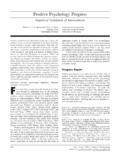Transcription of Journal of Research in Personality 33 ... - Jordan Peterson
1 Journal of Research in Personality33,208 232 (1999)Article ID , available online at onThe Big Five Personality Traits and the Life Course: A 45-YearLongitudinal StudyStephen Soldz and George E. VaillantStudy of Adult Development, Harvard Medical SchoolOne hundred sixty-three men who have been followed prospectively for over 45years were rated on a set of 25 Personality traits at the end of their college careersand took the NEO-PI at approximately ages 67 68. The college traits were trans-formed, via a rating procedure, to scales assessing each of the Big Five dimensionsand related to the NEO-PI. Three traits Neuroticism, Extraversion, and Open-ness exhibited significant correlations across the 45-year interval. Furthermore,the trait profiles remained relatively stable over that interval.
2 Both sets of personalitytraits were related to a wide variety of life course variables representing the domainsof global adult adjustment, career functioning/success, creativity, social relations,mental health, substance abuse, childhood characteristics, familial history of pathol-ogy, maturity of defenses, and political attitudes. Conscientiousness in college wasthe best predictor of what happened to the men in the future, whereas Neuroticismin late midlife was the best correlate of life course functioning across a variety ofdomains. 1999 Academic PressFor over 45 years, researchers have been following a group of men fromthe Harvard classes of 1939-1944 using repeated interviews and question-naires to document their functioning in a variety of domains, including globaladult adjustment, career functioning/success, creativity, social relations,mental health, substance abuse, childhood characteristics, familial history ofpsychopathology, maturity of defenses, and political attitudes (Vaillant,1974, 1976, 1977; Vaillant, Meyer, Mukamal, & Soldz, 1998).
3 Previouswork has found that global mental health and maturity of defenses are potentpredictors of functioning in a variety of domains over the life course (Vail-lant, 1974, 1976, 1977; Vaillant & Vaillant, 1990a, 1993). In this study weextend previous work on this sample by relating these life course outcomesto the Big Five Personality traits as assessed by observer ratings at the endof college and self-reports at age 67. We further examine the stability of theBig Five traits over this long work was supported through the assistance of NIMH Grant MH-00364 and MH-42248to George E. Vaillant, Principal correspondence and reprint requests to Stephen Soldz, Director of Research , Healthand Addictions Research , Inc., 419 Boylston St., Suite 801, Boston, MA $ 1999 by Academic PressAll rights of reproduction in any form AND THE LIFE COURSE209In recent years, a broad, though by no means universal, consensus hasdeveloped that the structure of the Personality trait domain can be encom-passed by the five superordinate Big Five dimensions of Neuroticism, Extra-version, Openness to Experience, Agreeableness, and Conscientiousness(John, 1990; McCrae & Costa, 1990; McCrae & John, 1992; but cf.)
4 , Block,1995). The first finding driving this consensus was that the same basic factorstructure has emerged from a broad range of Personality judgments derivedvia a variety of instruments and methodologies ( , Goldberg, 1990; Nor-man, 1963; Soldz, Budman, Demby, & Merry, 1993a,b; Tupes & Christal,1961). The second finding contributing to the consensus was the considerableconvergence between the self-reported trait ratings and ratings of others whowell know the individual. In addition, there is convergence between observerratings, whether the observers are spouses or peers (Funder & West, 1993;John & Robbins, 1993; Kenny, 1994; McCrae & Costa, 1987). Somewhatconflicting results, however, were obtained by Soldz, Budman, Demby, andMerry (1996) with a clinical population of Personality -disordered patientsin group general, the evidence indicates that, at least fornonclinical populations, the Big Five traits have a replicable factor analyticstructure and exhibit considerable consensual a broad consensus on the structure of the trait domain developed,work on traits moved on to examining stability and change in the traits overtime and to explicating the meaning of these traits for individual functioningover the life course.
5 Among the questions asked are: To what degree dothese traits change over time? Are any apparent changes noted meaningfulor are they merely random noise? What are the relationships between thesetraits and other aspects of individual functioning over the life course? Dothe relationships between traits and life course functioning change over time?The present study seeks to illuminate these questions using data from a co-hort of men who have been followed from 1942 to OF PERSONALITYThe typical longitudinal study administers the same Personality instrumentto the same individuals at least twice. With such data, one can investigatefive different types of Personality stability that have been identified by Caspiand Bem (1980). Three of these differential stability, ipsative stability, and1 They found that, while there was strong convergence on all five traits between the othergroup members viewing a given target patient and between therapists and these other groupmembers, only for Extraversion was there convergence with the ratings of the patient him-/herself.
6 Budman, Demby, Soldz and Merry (1996), in examining the outcomes of the patientsin these same groups, also found that the trait of Neuroticism exhibited a significant declineover the 18 months of the treatment, providing the first data relevant to the possibility raisedby McCrae and Costa (1990) that these traits may change over the course of AND VAILLANT coherence are of interest for our purposes in that they can be assessed bythe current data, which uses different Personality measures at ages 22 Stability [also referred to as rank order stability by McCraeand Costa (1990)] refers to stability in the relative placement of individualswithin a given groupon a given trait over time. Ipsative Stability refers tostability,within a given individual,of the relative importance or salience ofa given trait, relative to other traits, over time.
7 Finally, Coherence refers toconsistency over time of a presumed genotype that underlies (possibly differ-ent) phenotypic behaviors at different points in the life these three types of trait stability, most attention in adult developmentalresearch has focused on Differential Stability. With the notable exception ofBlock s (1971) classic study of adolescent development, Ipsative Stabilityhas been largely ignored. Coherence has largely been studied in the contextof continuity from childhood to adulthood ( , Caspi, Bem, & Elder, 1989;Ryder, 1967) rather than across long stretches in regard to Differential Stability, Costa and McCrae (1988, 1994) havemade a strong case that, in terms of rank order, Personality traits are largelyunchanged after the age of 30. They have found that, over a 6-year interval,test retest correlations for the three Big Five traits for which they had dataare almost as high as those between ratings 2 weeks apart.
8 When disattenu-ated for reliability, these correlations were .90 or above. Costa and McCrae(1994) summarize the available stability coefficients in adult samples foreach of the five factors and find a median retest correlation for four of thefive factors of .64 and for one factor of . major longitudinal studies of Differential Stability have essentiallysupported the Costa and McCrae position. Finn (1986), for example, foundevidence that 30-year MMPI stability was greater for men originally ages43 to 53 than for men originally ages 17 to 25, although in both cohortsstability was high. A few studies have, however, found some evidence of traitchange during adulthood (Haan, Millsap, & Hartka, 1986; Jones & Meredith,1996; Wink & Helson, 1993)The present study contributes to the literature on trait stability by investi-gating the Differential and Ipsative Stability and Coherence of the Big Fivetraits over a 45-year interval.
9 In the 1940s, when our sample was first as-sessed, contemporary Personality instruments assessing the Big Five traitswere not in existence. Our sample of 163 men was, however, extensivelystudied during college, including interviews with the men several times ayear and interviews with their mothers. At the end of their college careers,each man was rated for the presence of 25 Personality traits that were definedfor this study. When viewed in retrospect, these traits were rather idiosyn-cratic in nature and definition. For example, one trait labeled Just So wasdefined as As group of men who are strongly systematic, neat, meticulous, Personality AND THE LIFE COURSE211and who depend on orderly routine and regularity. They are rigid and aptto be upset if their established habits and ways of living are interrupted.
10 (Heath, 1945, p. 25 ). The idiosyncratic nature of these traits posed a chal-lenge to our ability to explore their stability. The existence of the Big Fivetrait taxonomy presented a solution to the difficulty. The men had been as-sessed at approximately ages 67 68 on the NEO- Personality Inventory(NEO-PI; Costa & McCrae, 1985). By reducing the idiosyncratic CollegeRatings to the Big Five taxonomy, we would be able to compare traits acrossthe 41decades for which we had data. The present article reports our find-ings regarding the Differential and Ipsative stability of the Big Five traitsover a 45 year interval. To our knowledge, this interval constitutes the lon-gest period of time over which stability of the Big Five have been are, however, four factors that should make the magnitude of thestability coefficients in this study smaller than those reported in many otherlongitudinal studies.







